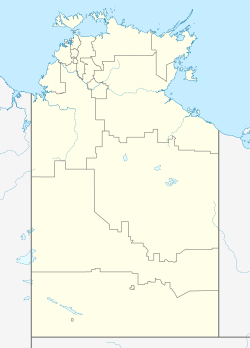| Numbulwar Northern Territory | |
|---|---|
| Coordinates | 14°17′0″S135°44′0″E / 14.28333°S 135.73333°E |
| Population | 672 (2006 census) [1] |
| Postcode(s) | 0852 |
| Elevation | 3 m (10 ft) |
| Location | 570 km (354 mi) se of Darwin |
| LGA(s) | Roper Gulf Region |
| Territory electorate(s) | Arnhem |
| Federal division(s) | Lingiari |
Numbulwar, formerly known as Rose River Mission, [2] is a small, primarily Aboriginal community on the Gulf of Carpentaria in the Northern Territory of Australia. The major tribal group of the community is Nunggubuyu and their language, Wubuy, is used by older generations. Kriol is also widely spoken.[ citation needed ]
Permanent settlement began in 1952 with the founding of the Rose River Mission by local Aboriginal communities and the Church Missionary Society.[ citation needed ]
The Mission operated until the 1970s when community control passed to the Numbulwar Numburindi Community Council.
The community consists of a general store, a police station, a community school, an engine repair shop, a post office and about 670 residents.[ citation needed ] Formerly, Mission Aviation Fellowship had a base in Numbulwar which provided air services for the community, but now residents use commercial companies for this service.[ citation needed ]
